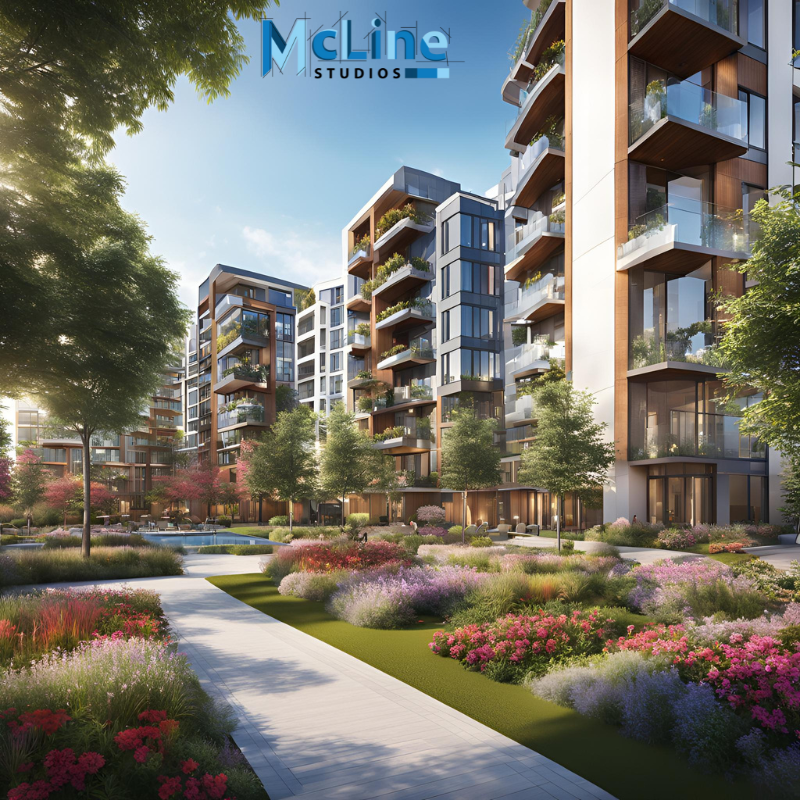In today’s dynamic residential construction landscape, effective communication and visualization are paramount for builders and designers seeking to differentiate themselves in a competitive market. Residential renderings, which utilize advanced 3D modeling techniques to create photorealistic images of proposed homes, play a crucial role in bridging the gap between concepts and reality.
The advantages of residential renderings extend beyond mere aesthetics; they enhance the entire project lifecycle, from initial concept development to final marketing strategies. By offering a clear visual narrative, renderings facilitate better client engagement and understanding, reducing miscommunication and aligning expectations.
Moreover, they serve as powerful marketing tools, attracting potential buyers by showcasing properties in their best light.
In this article, we will delve into five key benefits of residential renderings, highlighting how they empower builders and designers to create captivating, successful residential projects that resonate with clients and stand out in the market.
Benefit 1: Enhanced Visualization and Communication
Explanation: Renderings play a crucial role in the architectural and construction processes by providing a visual representation of the end product before any physical work begins. This allows all stakeholders—builders, designers, and clients—to engage with the project in a more meaningful way, ensuring that everyone is on the same page.
Detailed Points:
- 3D Visualization: With 3D renderings, builders and designers can easily visualize the design. This ability to see a model from different angles and perspectives enables teams to identify potential issues early in the design process. Designers can make necessary tweaks to improve functionality and aesthetics without the need for costly changes during construction.
- Bridging the Gap: Renderings serve as a vital communication tool that bridges the gap between a client’s vision and the technical drawings created by the design team. While technical drawings often contain intricate details, they can be hard for clients to interpret. Renderings simplify complex ideas into visual formats that clients can easily understand and relate to.
- Adjustment Capabilities: Renderings showcase how adjustments can be made to interior layouts, materials, colors, and finishes. For example, if a client is unsure about a specific color scheme or layout, the design team can quickly produce a rendering to demonstrate alternative options, enabling clients to make informed decisions.
Examples: For instance, a client may initially envision an open-plan kitchen but realize through a 3D rendering that a wall would enhance functionality. Renderings make such adjustments straightforward, allowing for an iterative design process that aligns with the client’s evolving vision.
Benefit 2: Improved Client Understanding and Engagement
Residential renderings significantly enhance clients’ understanding of their projects, creating a more immersive and satisfying experience. By translating complex technical plans into visually compelling 3D representations, these renderings eliminate confusion that often arises from traditional blueprints.
The engaging nature of visual renderings not only helps clients grasp the design intent but also accelerates the approval process, as they can see their ideas tangibly come to life. For instance, one client shared how a 3D rendering of their living room allowed them to envision the layout and color scheme, making them feel more involved and excited about the outcome.
Incorporating testimonials from clients who have experienced this engagement firsthand can further highlight the value of renderings.
Showcasing examples of 3D interior and exterior renderings will visually reinforce the concept, illustrating how clients can view their future homes from their perspective and better understand the intended design.
Benefit 3: Cost and Time Savings
One of the most significant advantages of utilizing 3D renderings in architectural projects is the substantial cost and time savings they offer. Accurate renderings enable project stakeholders to visualize the outcome and identify potential issues early in the design process, significantly reducing the likelihood of costly mistakes that can arise during construction.
Employing 3D renderings often leads to fewer change orders during construction, which are a common source of project delays and budget overruns. When clients and contractors have a clear understanding of the project’s visual and functional aspects from the outset, they are less likely to request changes once construction begins, leading to smoother project execution.
3D renderings optimize resource planning and material estimation. Accurately depicting dimensions and materials, teams can better estimate costs, streamline procurement processes, and ensure that the right quantities of materials are ordered, reducing waste and unnecessary expenditure.
Several industry examples illustrate these benefits. For instance, a major commercial building project utilized 3D renderings to highlight potential structural conflicts between HVAC systems and ceiling fixtures.
Benefit 4: Marketing and Sales Tools
Residential renderings serve as powerful marketing assets for builders and designers, playing a crucial role in attracting potential buyers and investors.
Incorporating high-quality visual presentations into brochures, websites, and social media platforms, builders can effectively showcase their projects and capture the attention of their target audience. Beautifully crafted renderings provide a tangible glimpse into the future, allowing prospective clients to envision the final product long before construction begins.
This ability to “sell” a design through stunning visuals can significantly enhance a project’s appeal in a competitive market. For instance, studies have shown that listings with high-quality renderings receive up to 80% more engagement compared to those without, ultimately leading to increased inquiries and sales.
To illustrate this point, a gallery of renderings used in various marketing materials can demonstrate the effectiveness of this approach, highlighting the artistry and professionalism that resonate with potential clients.
Benefit 5: Accurate Project Collaboration
Accurate project collaboration is significantly enhanced through the use of 3D renderings, which serve as a vital tool for aligning the efforts of designers, engineers, and construction teams.
These visual representations clarify the design intent, providing a shared reference point that helps all parties understand the project’s goals and nuances.
By offering a clear visual framework, 3D renderings reduce the likelihood of miscommunication between design and construction teams, ensuring that everyone is on the same page regarding the project’s specifications and requirements.
This alignment fosters smoother transitions from design to build phases, ultimately leading to fewer errors and more efficient project execution. As a result, teams can collaborate more effectively, leading to higher-quality outcomes and a more streamlined construction process.
Final Note
In conclusion, in an ever-evolving residential construction landscape, the importance of residential renderings cannot be overstated. As we’ve explored, these advanced visual tools enhance communication, improve client engagement, and lead to significant cost and time savings.
Offering builders and designers a clearer perspective on project outcomes, renderings facilitate a more informed decision-making process, ultimately reducing the risk of costly errors and change orders.
Moreover, the marketing potential of high-quality renderings allows builders to effectively showcase their projects, attracting potential buyers and increasing sales opportunities.
Lastly, by fostering accurate project collaboration, 3D renderings ensure that all stakeholders—from designers to construction teams—are aligned, leading to a more efficient construction process.
Incorporating residential renderings into architectural practices not only elevates the quality of design and client satisfaction but also enhances overall project success.
As the industry continues to advance, embracing these tools will undoubtedly empower builders and designers to create residential spaces that not only meet but exceed client expectations, setting a new standard in the market.







